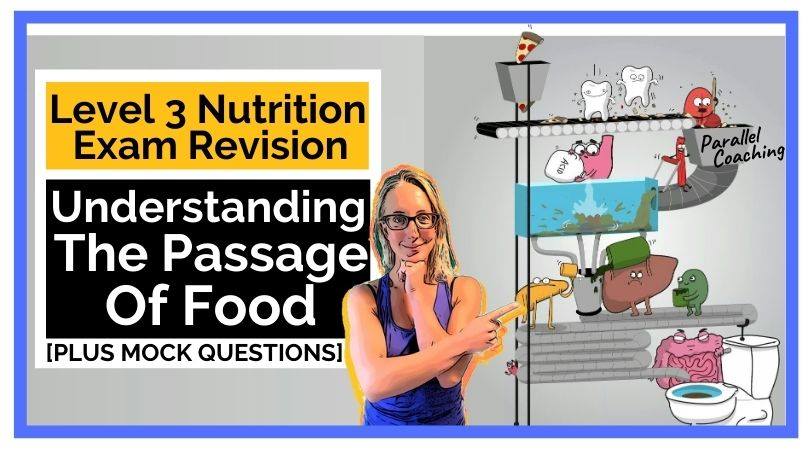This blog will help you learn and remember key information about the digestive system for your Level 3 Nutrition exam, including a story acronym about understanding the passage of food.
You’ll discover:
- Why FITPROs find the digestive system hard to revise
- A 12 mins Video Tutorial Understanding The Passage of Food
- Three Example Mock Question about The passage of food
- How to learn with simplicity for the rest of the L3 Nutrition Exam
Why FITPROs find the digestive system hard to revise
The Digestive system is notoriously claimed to be one of the hardest modules within the Level 3 Nutrition exam syllabus, so you are not alone if you find this area difficult to understand or remember.
Unlike other areas of anatomy (like muscles), we never get to see our intestines or stomach, which makes it feel theoretical. It may also feel like this is less directly related to training clients and giving advice as a FITPRO..
Although you might not actually be quoting the parts of the digestive system and how we pass food, with your clients. The knowledge of this is foundational and absolutely crucial in order to understand the deeper nutritional advice we give our clients.
A 12 mins Video Tutorial Understanding The Passage of Food
Understanding The Passage of Food
To help you remember the Passage of Food, we use a story acronym about a DJ in Los Angeles.
For a moment imagine Kate Moss is now a DJ and she is doing her DJ thing in LA.
Now the acronym that goes with this is MOSS DJ I LA
(aka Moss is a DJ In LA)
So let’s break down what this means:
M = MOUTH
The mouth starts the digestive process, with mechanical digestion via the teeth and tongue. Chemical digestion also starts here in the mouth, with Amylase (inside saliva) breaking down simple sugars.
O = OESOPHAGUS
This is a tube that connects the mouth to the stomach, and allows food to move in just one direction. A mechanism called peristalsis assists in ensuring the food moves down the oesophagus.
S = STOMACH
The stomach is like a carrier bag where food can be stored for 2-4 hours before moving onto the small intestine. The main role is to kill bacteria using hydrochloric acid, and the digestion of Proteins via and enzyme called Pepsin.
Then the mushed up food (called Chyme) leaves the stomach in small amounts (approx 1 tsp per minute) via the pyloric sphincter.
S = SMALL INTESTINE
The small intestine is a key area for both digestion and absorption. This is broken into three areas: The duodenum, jejunum and ileum
D = DUODENUM
This first section of the small intestine is all about breaking food down, especially carbs, fats, and proteins. This is when key enzymes like lipase are secreted from the liver and pancreas to help breakdown the macronutrients,
J = JEJUNUM
Finally, the food can be absorbed into the bloodstream. This area of the small intestine is lined with micro-villi , which are small hair-like finger protrusions. Their role is to increase the surface area and maximise absorption
I = ILEUM
Much like the Jejunum this is another site of absorption of key macronutrients. After absorption the carbohydrates become glucose when floating in the blood, and glycogen when stored. Protein becomes Amino Acids after absorption, and fats become fatty acids and triglycerides.
L = LARGE INTESTINE
The large intestine is where the waste products, that can’t be absorbed, are compacted together for easy excretion. This is the point that water and micronutrients are absorbed into the bloodstream
A = ANUS
The anus is the exit valve whereby waste faeces is excreted into the toilet. This concludes the end of the passage of food
Test your knowledge with today’s passage of food questions:
[NOTE: The answers are below the 3rd questions]
1. Which part of the digestive system allows for the absorption of water and micronutrients?
A. Duodenum
B. Large Intestine
C. Ileum
D. Stomach
2. What name is given to the sphincter between the stomach and duodenum?
A. Pyloric Sphincter
B. Stomach Valve
C. Bicuspid Sphincter
D. Jejunum Sphincter
3. Which enzyme breaks down protein in the stomach?
A. Bile
B. Pepsin
C. Amylase
D. Lipase
What’s the CORRECT answer?
Answers to the mock questions are :
Question 1= B, Question 2 = A, Question 3 = B
If you want more mock questions like this, then you can download more Free Mock Questions: DOWNLOAD NOW
Need More Help with your Nutrition Exam Revision?
For Trainee FITPROS Taking Their L3 Nutrition Exam.
Learn, Revise & Pass Your Level 3 Nutrition Exam In Under 10-hours
(Without Having To Spend Hours Revising Or Feeling Overwhelmed)
If you want to get your revision structured, learn everything you need to know and feel confident on exam day, then click the link below:

Dedicated to More
Hayley “Understanding The Passage of Food” Bergman
Parallel Coaching
P.S. You can also find us on the following platforms:
Instagram: Follow Now
Facebook: Like Our Page
Twitter: Tweet Us
YouTube: Subscribe Here
More Nutrition Revision Blogs: HERE

